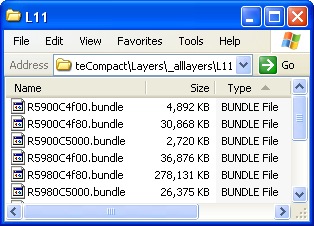In ArcGIS Server 10 we’ve introduced a new storage format for map caches that’s designed to make caches easier to move and store.
When you define the tiling scheme for a cache, you’ll now see the storage format choice of Exploded or Compact.
Exploded is the same format you worked with in earlier versions of ArcGIS Server, in which each tile is stored as a single file.
 Compact is the new format. It actually does not zip or compress the tiles in any way; rather, it groups the tiles together in large files called bundles. A single bundle can hold up to about 16,000 tiles. The result is a cache with dozens or hundreds of files, instead of thousands or millions. This speeds copying immensely, and is especially useful in workflows where you use a staging server to create tiles, then move the tiles to a production server.
Compact is the new format. It actually does not zip or compress the tiles in any way; rather, it groups the tiles together in large files called bundles. A single bundle can hold up to about 16,000 tiles. The result is a cache with dozens or hundreds of files, instead of thousands or millions. This speeds copying immensely, and is especially useful in workflows where you use a staging server to create tiles, then move the tiles to a production server.
The compact storage format also yields a smaller cache. Have you ever looked at a pre-ArcGIS Server 10 cache and noticed a discrepancy between “Size” and “Size on Disk”? This is because the smallest size that Windows can use to store a file is 4k by default. Unless you’ve changed the default format of your disk, any tile that’s less than 4k is going to waste space. That wasted space adds up when you have thousands of small tiles. With the compact format, you get a cache where the Size and Size on Disk are essentially the same because you are storing the data in large continuous streams.
ArcGIS clients, including the Web APIs, know how to read the bundle files produced by the compact cache format. If you’ve coded your own logic to pull tiles out of a virtual directory, you should continue to use the exploded format.
To read more about the compact cache format, see the “Storage settings” section of the topic Available map cache properties.
Contributed by Sterling Quinn of the ArcGIS Server software development team.

Commenting is not enabled for this article.